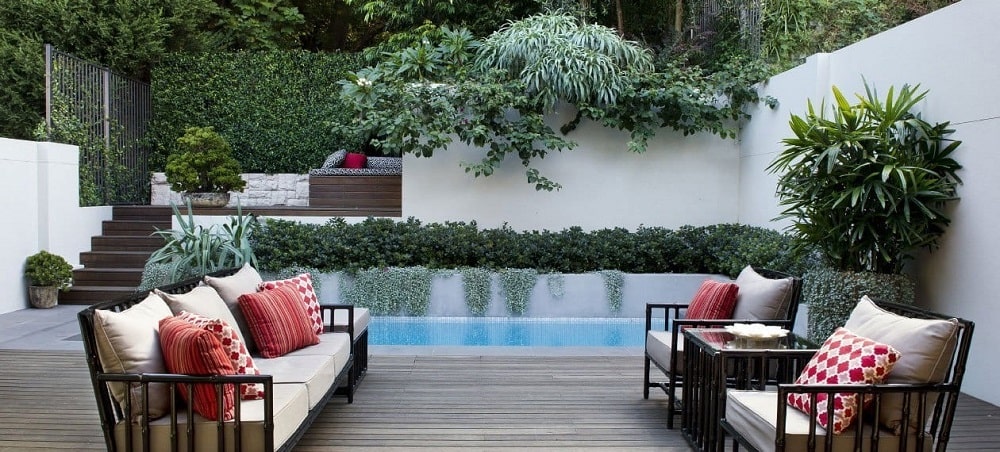
If you want to keep your garden simple and peaceful, then the minimalist garden might look suit you. With restricted plantings, neutral colors, and clean lines, this type of garden looks great in most modern homes.
Throughout history, gardens have been envisioned as ornate outdoor spaces crammed with a variety of colorful plants. However, history has evolved as life becomes increasingly fast-paced. The younger generation of homeowners look at gardens as functional, purposeful spaces that can look beautiful year-round with minimal input. Hence, modern design trends show a shift away from the traditional, high-maintenance version of a garden, adopting the mantra ‘less is more’.
Garden minimalism emphasizes a strong foundation comprised of clear architectural lines, defined structure and the use of plants and materials that are suited to local conditions. The result is an outdoor space with a timeless quality brought about by site-specific design that acknowledges local climate and environmental impact.
While it may seem to the eye the minimalist garden is easy to create, many garden experts say it is the most difficult style of garden – mostly due to the fact that it limits the number of hard landscape materials, plants, and colors.
We live in a loud world that encourages everyone to collect and amass. Which is why the temptation to throw in lots of hardscape materials, textures or colors is very strong for beginners. However, when it comes to minimalist gardening, the rule is to keep it simple. The goal of designers is to create a minimalist garden which requires easy care and presents a simple, relaxing, and peaceful appearance. In its purest sense, minimalism helps you to find your true self by removing the unnecessary and focusing on what truly makes you happy.
In this article, we will guide you through the basic steps of creating a calming minimalist garden. Before we go into the details, you need to consider some factors to decide if a minimalist garden is right for you.
Is a Minimalist Garden Right for You?
The choice of whether to have a minimalist garden really does depend on your personal style and the amount of time you want to spend gardening. This type of garden is an excellent choice for minimalist house enthusiasts, young urban professionals, or those who want to create an oasis from modern life. It also suits a person who travels frequently and prefers a clean, smart and low maintenance garden.
A minimalist garden should feature architectural planting, great vistas, and sculptures. Think carefully before choosing plants and other elements to make sure that you are creating a space to perfectly suit your aesthetic style and availability of time. You also need to consider your actual lifestyle rather than your idealized version of it. If your life involves kids or dogs, designing to accommodate things like a barbecue, storage, and a place to play are important.
So without further ado, let’s take a look at the steps involved in creating a minimalist garden.
How to Create a Minimalist Garden
Define the geometry of the space
This is the backbone of a minimalist design. The design geometry is influenced by the intended use and lifestyle of the client and by existing site conditions and features. Minimalist gardens utilize what is already there. If the site is sloping, create stepped terraces as in this steeply sloped garden designed by Good manors Pool + Garden.
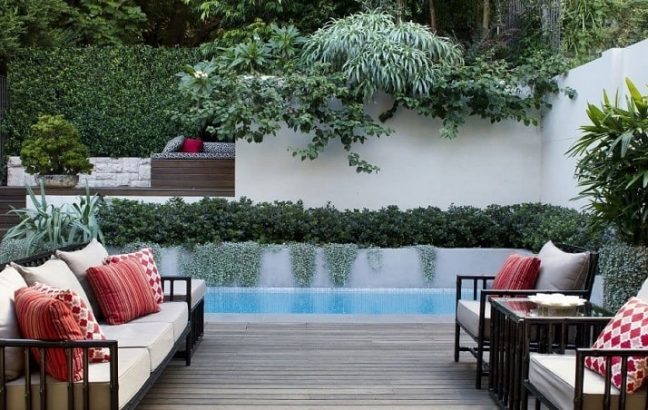
Designed by GoodManors
If the site features old, textured walls, use these as inspiration for the design. A useful tip when setting the geometry of the design is to center the design around an imaginary line of the axis that can be defined by any existing architectural or landscape elements such as a large window wall or a sculptural tree. This imaginary axis is then used to organize and connect the varied elements that form the major components of the design.
Create a sense of enclosure
The concept of the ‘outdoor room’ has resulted in the garden, becoming an extension of the house itself. Minimalist garden designs often comprise of well-defined zones be it a dining area or an area for lounging and indulging in conversation. Defining the boundaries of these zones imparts order and clarity to space. The boundary may be as simple as an evergreen hedge or a physical wall. It can even apply to micro-spaces within a garden such as a planter or gravel edging. Creating a balance between these zones through the use of plants, suitable materials or repeated landscaping features is vital in inducing a sense of harmony and oneness that is a defining feature of minimalist gardens. Amir Schlezinger’s rooftop garden artfully demonstrates this balance.
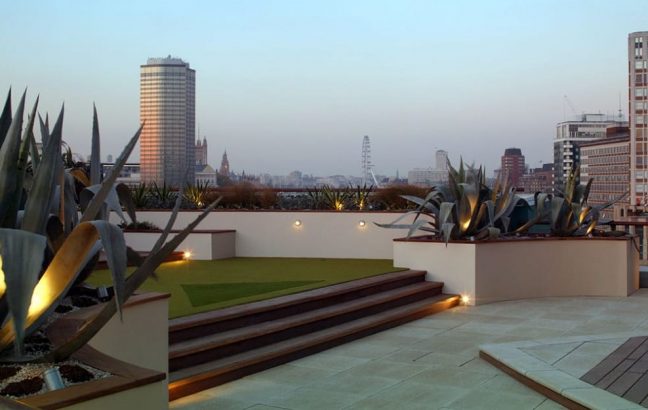
Via Mylandscapes
Perfect your paving
Paving is an integral component of any minimalist design and should be simple, clean yet immaculately detailed and finished. It is the one element that can unify the entire design and as such needs careful consideration. Old materials are often an inspiration for new applications in modern, minimalist gardens: gravel, pebbles, and stones traditionally used for river beds or to provide access (stepping stones) through a bed of lawn are used in creative compositions that challenge these traditional uses.
Timeless materials such as stone or wood used in a simple, straightforward paving pattern can create a peaceful ambiance in the garden. They can also be used in beautifying challenging spaces such as very shady or very hot spots. Polished concrete is another favorite. Each of these materials is extremely weather-resistant, hardy and has unique color and texture that can make them stand out in a landscaping composition. Many of these materials can also be recycled or procured from environmentally responsible sources, making them sustainable design options. The attention to detail, such as the thickness of paving joints, edge detailing and desired texture, is key to achieving the crisp, clean look that is characteristic of minimalist landscapes as is evident in this patio design by Amir Schlezinger.
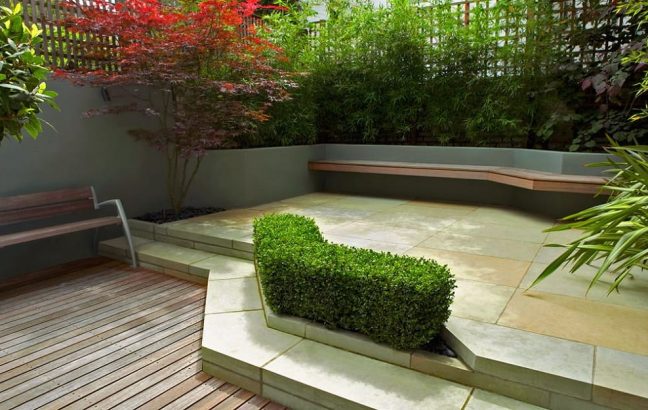
Via Mylandscapes
Limit your plant palette
Minimalist design is all about restraint, avoid opting for too many plant species. Limit the number of plants specified in the design and use these repeatedly throughout the garden. This creates a visual link through the outdoor space and helps to create a cohesive, balanced design. It also has the added advantage of easy maintenance, aiding in the efficient use of time and money to keep the garden looking fresh and neat year-round. Mass planting is an effective technique and one used often by designers in modern gardens. There is something to be said about the effect of a swathe of gently swaying Pennisetum grasses, planted together, they are so much more effective than single plants scattered throughout the garden as can be seen in this front yard retreat designed by Shades of Green Landscape Architecture.
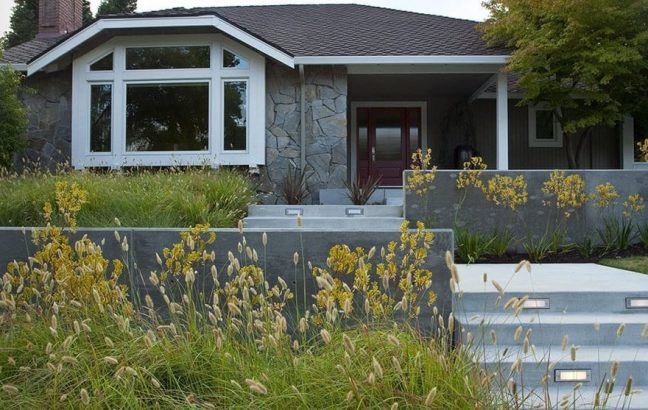
Via Shades of Green Landscape Architecture
Layering plants from tallest to shortest also ensures balance in both the vertical and horizontal proportions of a planting area. Taller sculptural plants are popularly used to provide focal points, counterbalance hard corners and complement paving and hard surfaces. Planting in minimalist gardens functions not just as a filler for leftover space, but as an anchoring element in its own right as is demonstrated in this garden by Tim Davies Landscaping.
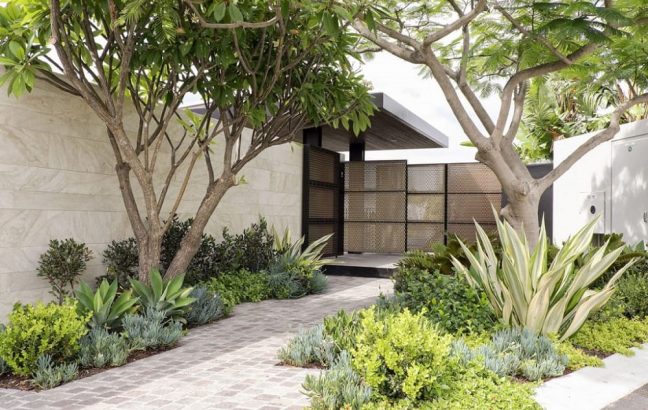
Choose colors carefully
To achieve a sense of peace and harmony, minimalist designs generally veer towards muted color palettes that are more reflective of nature. Greys, browns, and whites are popular choices for hardscape and built structural elements. Using tonal variations of the same color is an effective strategy for maintaining balance. David Webber uses this strategy in this Texas residential garden design.
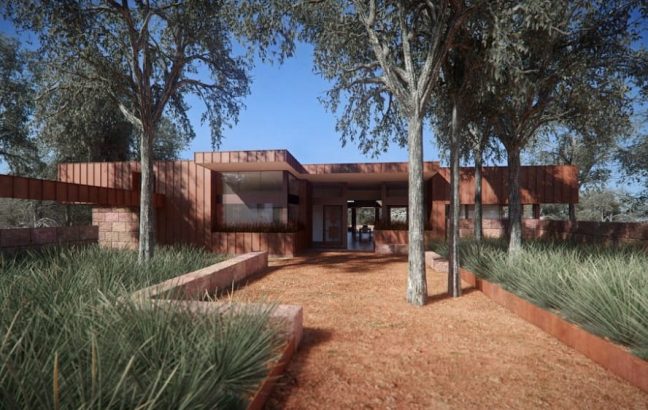
Via Webber+Studio
Neutral colors also provide the perfect backdrop for green plants, which can be used to provide a spot of color. When planting, designers tend to select plants for their textures and complimentary shades of green rather than for the color of their inflorescence. This ensures that a garden will transcend seasons and look well-maintained for years to follow.
Conclusion
To summarize the key features of a minimalist garden design, the golden rule is to design for a purpose. Every element in the garden should have a specific purpose, the overall design should strive for balance and proportion to ensure a soothing, calming outdoor space that can be enjoyed for years to come.
Designing the garden to suit your personal lifestyle is an important first step in determining how the garden will be used. This will help to set the defining parameters for the design.
Next, select locally sourced plants and materials as these are likely to thrive in adverse climatic conditions with little or no maintenance. Color, form, and texture are tools that should be used to reinforce balance and scale within the garden. All of these elements, when linked together purposefully, result in an oasis of tranquility amidst the turmoil of modern life.